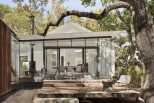A private redevelopment project that wanted to unite contemporary functionality and charm of unspoiled nature. An existing pre cottage…

“I am almost obsessed with the subject of materials in architectural composition and furnishings, whether we’re talking about natural materials like marble or stone, or artificial materials, glass, ceramics or metal, right through to new composite and synthetic materials. The study of how these materials are processed, cut and texturized and the relationship that this creates with artificial or natural light defines the whole series of sensations and perception that I want to attribute to the work.
The “skin” of the project, meaning everything to do with the outer finishing of the material, is fundamental for all the stages of architectural design. It’s not just a question of creating a shell, but of purposefully defining the way it relates to the surrounding space, giving the materials a range of possible ways to express themselves. This means that the materials of the future are those that have an intrinsic value in addition to simple performance, such as being energy saving, eco-friendly or recyclable.  During the 2012 Made Expo 2012, the Space for Life installation showed us the expressive potential of using wood to construct buildings for social housing projects. Its versatility allows it to be finished using other materials, without altering its performance in terms of its acoustic properties, elasticity, earthquake resistance and energy passivity in extreme temperatures.
During the 2012 Made Expo 2012, the Space for Life installation showed us the expressive potential of using wood to construct buildings for social housing projects. Its versatility allows it to be finished using other materials, without altering its performance in terms of its acoustic properties, elasticity, earthquake resistance and energy passivity in extreme temperatures.  Another future-friendly material is glass: both ancient and contemporary at the same time, it can be used in so many ways and forms, ranging from architecture to design. Glass is an essential material because it interacts with light and can be used to replace traditional architectural materials in order to add lightness and transparency to the spaces in contemporary buildings.
Another future-friendly material is glass: both ancient and contemporary at the same time, it can be used in so many ways and forms, ranging from architecture to design. Glass is an essential material because it interacts with light and can be used to replace traditional architectural materials in order to add lightness and transparency to the spaces in contemporary buildings.  A good example of this is the latest project for the Hotel Excelsior Gallia in Milan, with the new facade made from an irregular pattern of alternated dark and light frosted glass, exalting the building’s connection with the urban landscape. The use of glass was also the essence of the project for a villa on Lake Como, allowing the interior space to dialogue with the exterior, creating suggestive scenery.”
A good example of this is the latest project for the Hotel Excelsior Gallia in Milan, with the new facade made from an irregular pattern of alternated dark and light frosted glass, exalting the building’s connection with the urban landscape. The use of glass was also the essence of the project for a villa on Lake Como, allowing the interior space to dialogue with the exterior, creating suggestive scenery.”  “It is therefore essential to select the materials and study the continuity between architecture and interior space right from the design phase, in order to create a harmonic interaction between volumes and spaces.”
“It is therefore essential to select the materials and study the continuity between architecture and interior space right from the design phase, in order to create a harmonic interaction between volumes and spaces.”





